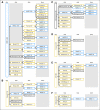Occurrence of multiple subsequent neoplasms in long-term survivors of childhood cancer: a report from the childhood cancer survivor study
- PMID: 21709189
- PMCID: PMC3157966
- DOI: 10.1200/JCO.2011.34.6585
Occurrence of multiple subsequent neoplasms in long-term survivors of childhood cancer: a report from the childhood cancer survivor study
Abstract
Purpose: Childhood cancer survivors experience an increased incidence of subsequent neoplasms (SNs). Those surviving the first SN (SN1) remain at risk to develop multiple SNs. Because SNs are a common cause of late morbidity and mortality, characterization of rates of multiple SNs is needed.
Patients and methods: In a total of 14,358 5-year survivors of childhood cancer diagnosed between 1970 and 1986, analyses were carried out among 1,382 survivors with an SN1. Cumulative incidence of second subsequent neoplasm (SN2), either malignant or benign, was calculated.
Results: A total of 1,382 survivors (9.6%) developed SN1, of whom 386 (27.9%) developed SN2. Of those with SN2, 153 (39.6%) developed more than two SNs. Cumulative incidence of SN2 was 46.9% (95% CI, 41.6% to 52.2%) at 20 years after SN1. The cumulative incidence of SN2 among radiation-exposed survivors was 41.3% (95% CI, 37.2% to 45.4%) at 15 years compared with 25.7% (95% CI, 16.5% to 34.9%) for those not treated with radiation. Radiation-exposed survivors who developed an SN1 of nonmelanoma skin cancer (NMSC) had a cumulative incidence of subsequent malignant neoplasm (SMN; ie, malignancies excluding NMSC) of 20.3% (95% CI, 13.0% to 27.6%) at 15 years compared with only 10.7% (95% CI, 7.2% to 14.2%) for those who were exposed to radiation and whose SN1 was an invasive SMN (excluding NMSC).
Conclusion: Multiple SNs are common among aging survivors of childhood cancer. SN1 of NMSC identifies a population at high risk for invasive SMN. Survivors not exposed to radiation who develop multiple SNs represent a population of interest for studying genetic susceptibility to neoplasia.
Conflict of interest statement
Authors' disclosures of potential conflicts of interest and author contributions are found at the end of this article.
Figures




References
-
- Horner MJ, Reis LAG, Krapcho M, et al. SEER Cancer Statistics Review, 1975-2006. Bethesda, MD: National Cancer Institute; 2009. http://seer.cancer.gov/csr/1975_2006/
-
- Mariotto AB, Rowland JH, Yabroff KR, et al. Long-term survivors of childhood cancers in the United States. Cancer Epidemiol Biomarkers Prev. 2009;18:1033–1040. - PubMed
-
- Meadows AT, D'Angio GJ, Evans AE, et al. Oncogenesis and other late effects of cancer treatment in children. Radiology. 1975;114:175–180. - PubMed
-
- Mike V, Meadows AT, D'Angio GJ. Incidence of second malignant neoplasms in children: Results of an international study. Lancet. 1982;2:1326–1331. - PubMed
-
- Neglia JP, Friedman DL, Yasui Y, et al. Second malignant neoplasms in five-year survivors of childhood cancer: Childhood cancer survivor study. J Natl Cancer Inst. 2001;93:618–629. - PubMed
Publication types
MeSH terms
Grants and funding
LinkOut - more resources
Full Text Sources
Other Literature Sources

